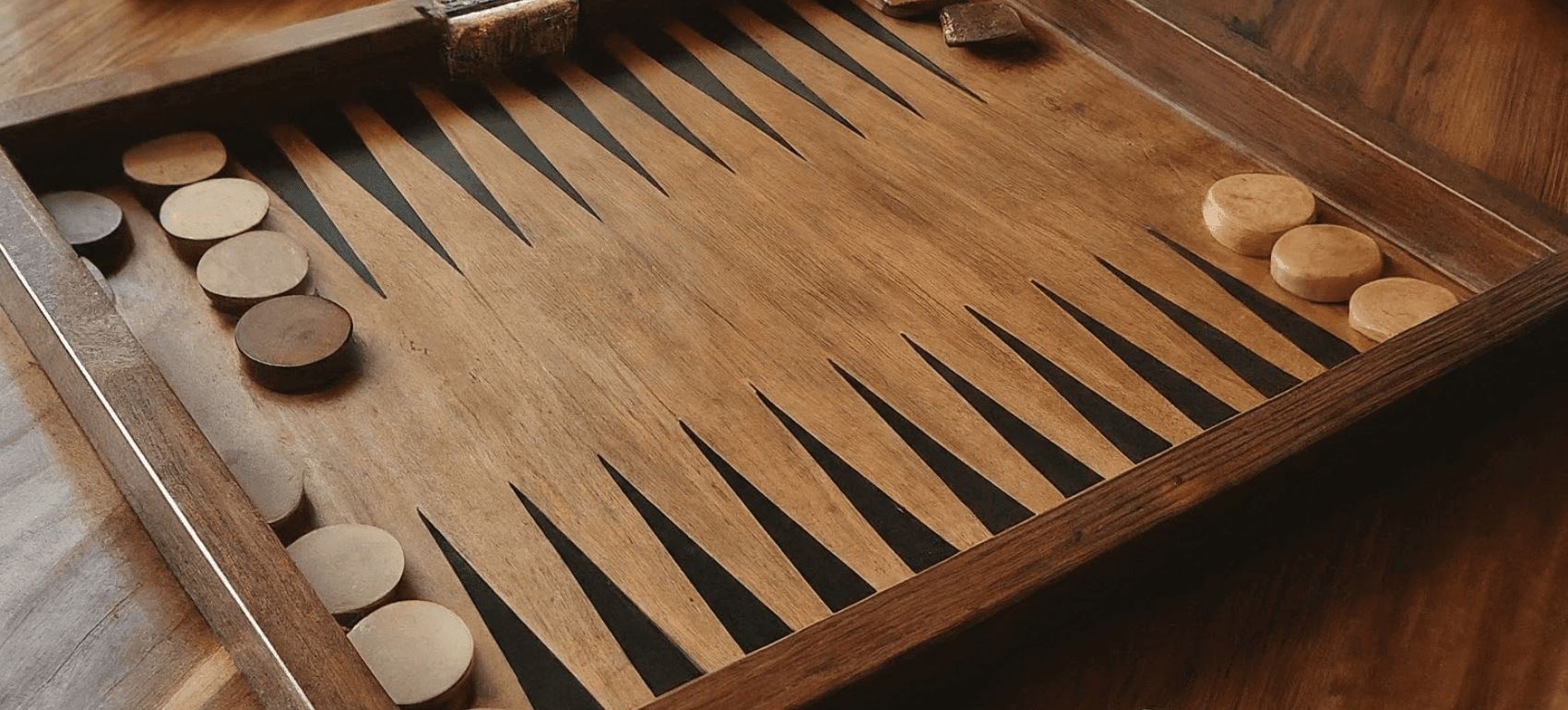
From Good to Great: Elevating Your Backgammon Skills with Pro Techniques
Understanding the Fundamentals of Backgammon
In the realm of board games, backgammon stands with a rich heritage, akin to possessing a set of large wooden chess pieces that exude luxury and tradition. Just as one would appreciate beautiful chess pieces received as a gift for dad, backgammon players cherish their game set, often handcrafted with precision and care.
To improve in backgammon, it is imperative to grasp the essential strategies that govern the game:
-
Opening Moves: Learning the best opening moves is the cornerstone of backgammon principles. Each roll of the dice presents a different scenario, and understanding the optimal way to play can provide an early advantage.
-
Probability and Risk Management: Like judiciously moving wooden chess pieces, artful backgammon requires assessing the odds. Players must evaluate potential outcomes and take calculated risks to position themselves favorably.
-
Blocking and Holding: Establishing anchors and creating a blockade can hinder the opponent’s progress, while holding points, in the same manner that strategic pieces guard important squares in chess.
-
Doubling Cube Strategy: Knowledge of when to offer or accept a double is a critical component that separates novices from seasoned competitors. This mechanic introduces a layer of strategic depth unique to backgammon.
-
Bear-Off Technique: Like the endgame in chess, understanding the intricacies of bearing off pieces in backgammon is vital. It involves skillful play to remove your pieces from the board while adapting to dice rolls and opponent moves.
Mastering these concepts lays the groundwork for advancing from a casual player to an expert, enhancing one’s capacity to manipulate the ebb and flow of the game with the finesse of a grandmaster deftly maneuvering chess pieces.
For comprehensive guidance, players can delve into a frequently asked questions (FAQ) resource to clarify game rules and strategic nuances, ensuring that the basics are second nature.
Analyzing Starting Positions and Opening Moves
Mastering backgammon requires a thorough understanding of starting positions and the implications of opening moves. Each game commences from a fixed setup, yet the dice inject an element of randomness that must be strategically navigated. The opening move is paramount in backgammon as it sets the tone for the entire game. It is where knowledge and probability intersect to create a foundation for victory.
Players should recognize that opening moves are not merely about moving checkers forward; they establish early defensive and offensive structures. Crafting a strong home board quickly or creating advanced anchors in the opponent’s board can change the dynamic of the game.
Pro players analyze both their positions and potential responses from the opponent. This includes evaluating the safety of checkers, the construction of blocking points, and the opportunity for hitting. They also consider the potential for flexibility and growth - does the opening move limit future possibilities, or does it keep options open?
To elevate backgammon skills:
- Familiarize yourself with the 15 standard opening moves dictated by the roll of the dice. Each one has various responses, and understanding the best reactions to each scenario is critical.
- Prioritize moves that allow for both offensive plays and defensive structures. Aim to create a balanced position that complicates the opponent’s strategy.
- Incorporate probability into your decision-making. Recognize which moves are statistically more likely to improve your position in the long run.
- Practice recognizing patterns. Identifying common formations and their potential evolutions helps in anticipating your opponent’s strategy.
- Review and analyze completed games. Scrutinize the effectiveness of your opening moves and adjust your play accordingly for future matches.
By diligently studying starting positions and the consequences of different opening moves, players can gain a significant advantage. Remember, a strong start is often key to a winning strategy in backgammon.
Strategic Placements: The Power of the Anchor
In the nuanced world of backgammon, strategic placements can make the difference between victory and defeat. One critical technique involves the use of the anchor—a defensive stronghold within the opponent’s home board.
The anchor works as a safe haven for a player’s checker and can be a thorn in the side for opponents, much like a set of large wooden chess pieces that control the middle of a chessboard. By strategically placing an anchor, players can accomplish several tactical objectives. They can stall an opposing player’s progress, create opportunities to hit blots, and serve as a launching point for counterattacks when the timing is right.
Positioning an anchor is a delicate balancing act. One must consider not only the current state of play but also anticipate potential shifts in momentum. Establishing a strong anchor often requires a blend of offensive and defensive maneuvers, akin to deploying luxury chess pieces in a robust yet versatile formation.
The parallels with chess are evident when considering the power of beautiful chess pieces—or in backgammon terms, checkers—acting as both defenders and attackers from this strategic outpost. An anchor can act as a gift for a dad in backgammon, providing a sense of security and a foundation upon which to build a successful strategy.
To effectively use an anchor:
- Place a checker on the opponent’s five-point early in the game, creating a stronghold.
- Utilize anchors to block opposing checkers from re-entering the board, increasing one’s chances of capturing them.
- Leverage the anchor’s position to build a prime, a consecutive series of blocked points, thwarting the opponent’s advancements.
In essence, the anchor is a tool for control and disruption, akin to placing a set of wooden chess pieces artfully on a chessboard, with each piece serving a critical role in the broader strategy. A well-placed anchor is an art form, resonating deep within the strategic paradigms of backgammon mastery.
Probability and Risk Management in Backgammon
In backgammon, just as in a game featuring a set of wooden chess pieces art 809125, understanding the probabilities of certain outcomes is crucial to consistent success. Expert players make calculated risks by analyzing positions and potential dice rolls, underpinning their strategies with sound probabilistic judgment. This nuanced approach to risk can be likened to choosing a set of large wooden chess pieces; selecting pieces that not only have aesthetic value but also promise durability and quality performance over time.
Risk management in backgammon involves balancing aggressive play with defensive caution. It’s about knowing when to advance your checkers, when to hit your opponent’s blots, and when to fortify your positions. Beautiful chess pieces in a gift for dad may charm through their elegance, but backgammon pieces charm through their strategic placements on the board.
Here are key factors for managing probability and risk:
-
Dice Combinations: Understanding the likelihood of various dice roll outcomes is a foundational skill. Players must frequently assess the probability of specific dice combinations to anticipate future moves.
-
Positional Play: Skilled players recognize when the board’s configuration is in their favor and play conservatively or aggressively as the position dictates.
-
Match Play vs. Money Play: Probability assessment differs in match play versus money play. In match play, the score may dictate taking greater risks or playing more safely.
-
Pip Count: Keeping a mental tally of the pip count affects decision-making. Players can evaluate whether to race, hold, or attack based on their positional pip advantage or disadvantage.
-
Equity Calculations: More advanced players calculate equity - the expected value of a position after considering all possible outcomes and their probabilities.
-
Doubling Cube: Mastering the doubling cube is an advanced form of risk management; knowing when to double or accept a double entails complex probabilistic assessment.
In conclusion, supreme backgammon performance requires more than just the ability to move checkers across a board; it demands precision in probability and risk management akin to choosing luxury chess pieces – each move must be a synthesis of beauty, utility, and strategic acumen.
Advanced Doubling Cube Strategies for Increased Stakes
In the realm of backgammon, much like a set of large wooden chess pieces symbolizes sophistication in chess, the doubling cube represents a layer of complexity and psychological warfare. Seasoned players understand that effectively manipulating the cube can dramatically increase stakes and turn the tide of the game. Here are advanced strategies to elevate its use:
-
Timing the Double: The most critical aspect of cube strategy is deciding when to double. A premature double might be refused, ending the game without adequate profit, while a late double might grant your opponent too much time to recover. The key is to double when you have a strong but not decisive advantage.
-
Crawford Rule Consideration: In matches, the Crawford Rule—where no doubling is allowed in the game following a player reaching match point—can affect strategy. Anticipate this by adjusting your doubling tactics in the games leading up to this pivotal point.
-
Beckett’s Ratio: Familiarize yourself with Beckett’s ratio, a tool that balances the probability of winning against the potential loss of the gamble. This heuristic can guide you on when to offer or accept a double based on the current score and inherent risks.
-
Psychological Leverage: Sometimes the cube is wielded not just for its mathematical implications but for its psychological impact. Offer a double to apply pressure on your opponent or to cast doubt on their position, especially when they have shown hesitation or conservative tendencies.
-
Volatility Awareness: Evaluate the volatility of the game state. A volatile position with many possible outcomes favors the doubling player, as it magnifies the effect of the cube. A stable position, however, may suggest holding off on doubling.
-
Resisting Redoubles: Know when to take and when to drop a redouble. If your opponent offers a redouble and the game is at a critical juncture where the stakes have grown exponentially, a well-calculated pass can prevent catastrophic losses.
Mastering the doubling cube is akin to finding the perfect gift for dad—a thoughtful consideration of risks, rewards, and the psychological understanding of the opponent. As with beautiful chess pieces enhancing the artistry of a game, the doubling cube can transform a simple backgammon match into a thrilling battle of wits and strategy.
The Psychological Game: Reading Your Opponent
In the cerebral arena of backgammon, mastering the psychological aspects can be as crucial as strategic gameplay. The finesse employed in reading an opponent transcends mere observation; it’s akin to an intricate dance where each step reveals a new layer of intention and strategy.
Discerning an opponent’s stylistic leanings—whether they favor aggressive play, exhibit a proclivity for risk, or adopt a more defensive posture—can provide invaluable insights. By keenly observing their reactions to both favorable and unfavorable rolls, a player can glean patterns in their adversary’s decision-making process. In backgammon, as in chess, this intel is a potent weapon.
Furthermore, the interplay of bluffs and counter-bluffs cannot be overstated. A seasoned player knows when to feign weakness to lure their opponent into overcommitting or when to project confidence to disguise their own precarious standing. This mental jousting adds a layer of complexity to the game, transforming each turn into a psychological duel.
The adept backgammon player also recognizes the importance of disrupting an opponent’s rhythm. Like a set of large wooden chess pieces that stand firm on a board, a backgammon player must be equally unyielding in their psychological presence. Creating uncertainty in the opponent’s mind can lead to hesitation and unforced errors, providing strategic advantages.
Lastly, while a beautiful chess pieces gift for dad might delight on a birthday, in backgammon, the true gift is the ability to adapt and readjust tactics in response to the shifting sands of your opponent’s psyche. This dynamic interplay, when mastered, can elevate one from a good player to a great one—a player who holds not just the dice but the psychological threads of the game in their hands.
Timing Matters: When to Hold and When to Race
In the nuanced world of backgammon, discerning the optimal moments to switch gears from a holding game to a sprint towards home is a testament to a player’s strategic prowess. Much like a set of wooden chess pieces art 809125 waiting to move across the board, backgammon checkers must be maneuvered with precision and foresight.
Timing is a crucial element in backgammon.
When to hold:
- A holding game typically unfolds when you’re lagging behind, and you possess anchors or points in your opponent’s home board.
- Holding should also be considered if your opponent has a blot in their home board, which you can strike, disrupting their game plan.
- This passive, defensive approach can also pay dividends when the race is too close to call, buying time to capitalize on future rolls.
When to race:
- Opt for a racing strategy when you are ahead in the pip count and your pieces are well-positioned. This resembles the sleek appearance and swift deployment of large wooden chess pieces in a luxury chess set.
- If you have successfully borne off most of your checkers and the likelihood of getting hit is low, it’s time to shift gears and race to the finish.
- Push into a race when your opponent’s bar is cluttered. Each roll they waste trying to enter from the bar is an opportunity for you to inch closer to victory, much like a gift for dad that adds joy with every move.
Mastery of timing ensures no checker is wasted, akin to the optimal use of beautiful chess pieces on a chessboard.
Striking this delicate balance between holding and racing can spell the difference between a good backgammon player and a great one. It requires attentive monitoring of the match dynamic, perfecting the interplay between defensive positioning and the ongoing race tally. Remember, the right move at the right time can be as impactful as the revelation of a queen among a set of intricately carved chess pieces.
Expert Moves: Knowing When to Slot and When to Split
Elevating one’s backgammon prowess involves mastering the delicate balance between offensive and defensive play. Two critical decisions in this strategic board game are when to slot and when to split one’s checkers. These moves can be game-changers in transitioning from good to great play.
Slotting refers to placing a single checker on a point within one’s own home board, with the goal of creating a blockade or establishing anchors. This technique is a strategic risk; it tempts the opponent to hit a blot (a single checker on a point), but if left untouched, it can reap high rewards. Expert players understand that slotting is optimal when:
- The advantage in the race is significant, lowering the risk of being hit.
- The opponent’s home board isn’t sufficiently developed to easily capture the blot.
- There is potential to quickly secure the slotted point on the next turn.
On the other hand, splitting checkers means separating them, typically those in the player’s home board, with the intention of advancing them to more strategic positions. Splitting is advisable when:
- The player intends to escape the checkers from the opponent’s home board.
- The board position suggests that the opponent cannot easily hit the split checkers.
- It helps in creating advanced anchors, disrupting the opponent’s game plan.
Astute backgammon players continuously assess the risk versus reward of both slotting and splitting. They observe the state of the game, the dice rolls, and the opponent’s strategy. Knowing when to employ these moves can be the difference between winning and losing, just as choosing a set of large wooden chess pieces can turn a game from ordinary to extraordinary. These expert moves are akin to the beautiful chess pieces in a set: distinct, vital, and with the potential to be powerfully effective. They can indeed be a beautiful and transformative gift for your backgammon strategy, just like a luxury chess set would be a perfect gift for dad.
Practice Makes Perfect: Developing a Regimen for Skill Enhancement
In the quest to excel in backgammon, establishing a regular practice regimen is as crucial as having a set of large wooden chess pieces for chess aficionados. To hone one’s skills effectively, a player must create a disciplined and structured practice routine that addresses different aspects of the game. Here are several strategies to develop an effective backgammon practice regimen:
-
Study Openings and Endgames: Just as beautiful chess pieces line up for the game’s opening, backgammon requires a solid understanding of opening moves and endgame strategies. Dedicate time to memorize and practice key opening sequences and bear-off techniques.
-
Positional Play: Analyze positions by setting them up on a backgammon board, akin to arranging a set of wooden chess pieces art 809125. Work through various scenarios to improve your strategic decision-making.
-
Backgame Skills: Deliberately practice playing backgames, one of the more complex strategies in backgammon. Learning to manage these situations can dramatically improve your competitive edge.
-
Probabilities and Odds: Like measuring the odds before taking a chess piece, in backgammon, it’s crucial to understand the probabilities. Regular practice with dice probability helps in making informed decisions during gameplay.
-
Recorded Match Analysis: Just as luxury chess pieces become more valuable with time, so does the experience from analyzing past games. Record and review your matches to identify strengths and weaknesses.
-
Opponent Study: Prepare for a variety of playing styles by studying different opponents, much like how one anticipates the strategy behind a gift for dad chess set.
-
Timed Decisions: Use a clock to simulate real match conditions, forcing you to make decisions within a time frame. This instills a sense of urgency and mimics tournament play.
In summary, a rigorous and methodical practice regimen is invaluable for skill enhancement in backgammon. Engaging regularly in these activities is akin to a chess player mastering the movements of each unique chess piece, ensuring that over time, proficiency in backgammon will not be left to chance, but will be the result of dedicated effort and strategic practice.
Learning from the Pros: Incorporating Pro Techniques into Your Game
To transition from good to great in backgammon requires more than just mastering the basic rules; it involves the adoption of advanced strategies and mindsets used by professional players. Enhancing your game with pro techniques can make you a formidable opponent on any board, be it a set of wooden chess pieces art 809125, or a selection of large wooden chess pieces designed for luxury games.
One such technique is the proper utilization of the doubling cube. Pros use it aggressively but judiciously, understanding when the odds are in their favor and the potential payoffs are worth the risk. Analyzing positions for the best moments to offer a double or accept a doubling challenge is crucial.
Another aspect to gain from experienced players is the strategic placement of checkers. Pros often establish advanced anchors, creating strong points in their opponent’s home board, which serves both as a defensive mechanism and an offensive foothold to re-enter the game after being hit. They also adeptly spread their checkers, balancing the establishment of points with flexibility for future moves.
Professional backgammon players also excel in the endgame. They calculate pip counts with precision and structure their bear-off strategy to minimize the risk of leaving a blot. A great backgammon player plans several moves ahead, maintaining the flexibility to adapt their strategy when the dice do not roll as expected.
Blot hitting and re-entry are also areas where one can learn from the pros. They know when it’s strategically advantageous to hit a blot, taking into account the overall board layout, pip count, and their opponent’s vulnerabilities.
Finally, an often-overlooked but vital pro technique is error reduction. Even with beautiful chess pieces, such as luxury chess pieces or a gift for dad, deliberate and thoughtful play minimizes costly mistakes. Pros consistently review their games, learn from their errors, and thus continuously refine their decision-making process.
Adopting these strategies won’t just elevate your game; it will transform how you compete, advancing your play from good to great.
Common Mistakes to Avoid on the Path to Greatness
Elevating from good to great backgammon skills demands not only practice but also a strategic approach to learning the game. As players trade in their basic boards for sets like a luxurious set of large wooden chess pieces, they must also upgrade their playing techniques. A beautiful chess set, such as a set of wooden chess pieces art 809125, can be motivational, but the transformation from competent to superior requires avoiding common pitfalls.
-
Neglecting the Opening: Mastery begins with the opening moves. Many players overlook structured opening strategy in favor of spontaneous play, forgetting that specific opening sequences can lead to advantageous positions.
-
Overlooking Cube Strategy: The doubling cube is a unique feature of backgammon that can change the course of the game. Failing to understand cube dynamics or mishandling cube decisions can be costly.
-
Playing Defensively: Being overly cautious and defensive prevents taking calculated risks that could lead to victory. Players must balance defense with aggressive strategies.
-
Ignoring Match Play Dynamics: Match play has its own set of rules and scoring system. Not adapting strategies accordingly is a mistake that can hinder advancement.
-
Dismissing the Psychology of the Game: Backgammon is not just about the move on the board; it’s also about outsmarting the opponent. Players who do not leverage psychological tactics often miss opportunities to disrupt their opponent’s strategy.
-
Failing to Study and Analyze Games: A critical component of improvement is the post-game analysis. Neglecting to review and learn from past games, including those of high-level players, is a missed opportunity for growth.
-
Lacking Patience: Patience is a critical virtue in backgammon. Impatient players may rush their turns or make impulsive decisions, leading to errors and missed opportunities.
Aiming for greatness in backgammon is akin to selecting a gift for dad that signifies excellence - like a set of large, luxurious chess pieces; it’s not just about the aesthetic, but also the legacy of strategic prowess one builds. Avoiding these common mistakes is key to not just playing, but excelling in the sophisticated world of backgammon.
Studying Classic Matches: Gaining Insights from Historic Games
Analyses of historic backgammon games are akin to examining a set of wooden chess pieces art 809125—each move, strategy, and decision offers a nuanced look into the mastery required for both games. Delving deep into classic matches equips aspiring backgammon champions with a plethora of benefits and can be the cornerstone of their journey from good to great.
When dissecting legendary games, enthusiasts have the opportunity to understand how the greats maneuvered through complex situations. Observing how each player navigates opening moves, mid-game transitions, and endgame techniques can serve as a template for one’s strategic approach. As one would admire the craftsmanship of large wooden chess pieces, players can appreciate the tactical finesse of backgammon experts.
Evaluating these games isn’t just about learning moves but also about grasping the psychological warfare often at play. Gifted players are able to anticipate their opponent’s moves, weigh risks confidently, and leverage opportunities—all under the pressure of competition. Like luxury chess pieces on a board, each backgammon checker’s move is a statement of intent and skill.
Moreover, studying historic matches:
- Sharpens decision-making abilities by seeing the consequences of various strategies played out.
- Enhances board visualization skills, allowing players to see potential moves several turns ahead.
- Improves understanding of backgammon probabilities and the odds associated with different dice rolls.
- Cultivates adaptability to change one’s game plan effectively in response to the dynamic nature of the game.
Whether it’s for a casual game or a gift for dad who loves strategy games, embracing the legacy left by backgammon maestros is a surefire way to elevate one’s play. Historically rich and tactically profound, these classic matches are not just games—they’re a treasure trove of lessons waiting to be learned.
Utilizing Technology for Improved Play: Software and Apps
In a digital era where every classic game is reverting to online counterparts, backgammon is no exception. Enthusiasts are leveraging software and apps to hone their skills, transcending the traditional boundaries of a set of wooden chess pieces artfully crafted. An indelible wave of innovation is sweeping through the backgammon scene, as players now have access to a plethora of tools to improve their game.
-
Analytical Software: Advanced software has become a critical tool for players aiming to elevate their backgammon prowess. These systems can analyze games, pointing out suboptimal plays and suggesting better alternatives. By meticulously reviewing sessions, players can understand their weaknesses and recalibrate their strategies.
-
AI Opponents: Instead of settling for human adversaries whose skill levels may not always match their own, players can now practice against sophisticated AI opponents. These AIs are often designed to play at varying difficulty levels, providing a consistent challenge that scales with the player’s growing expertise.
-
Mobile Apps: The convenience of backgammon apps has transformed smartphones into portable arenas for sharpening tactics. Whether it’s a set of large wooden chess pieces or a virtual board, these apps facilitate regular practice against a global pool of players.
-
Tutorials and Guides: For newcomers or those seeking to polish a specific aspect of their game, online tutorials and interactive guides offer step-by-step instructions. While a luxury chess piece might make a beautiful gift for dad, the gift of mastery through educational apps can be equally profound.
-
Tracking Progress: Some apps include features for tracking progress over time, allowing players to see their improvement in a tangible way. Consider this as the analytical counterpart to the aesthetic pleasure of acquiring exquisitely crafted beautiful chess pieces.
By incorporating technology into their practice routines, backgammon enthusiasts are unlocking new dimensions of strategic play. The interplay between technology and technique ushers individuals from good to great, leveraging modern innovations to become champions of the ancient game.
The Importance of Positional Play and Board Visualization
In the sophisticated realms of backgammon, akin to the intricate world of chess where a set of large wooden chess pieces not only symbolize elegance but the layers of strategy they represent, positional play is fundamental. Veteran players understand that although luck plays a role, a well-formulated positional strategy often dictates the course of the game. Positional play involves optimizing the placement of checkers, anticipating opponent moves, and minimizing one’s own vulnerabilities.
Board visualization is a skill that allows a player to not simply see the board as it is but to foresee potential future game states. This cognitive ability is crucial in backgammon, where a single roll can significantly alter the landscape. Visualizing the board aids in recognizing patterns, which in much the same way a set of wooden chess pieces art 809125 can convey unspoken stories of past battles, it reminds players of strategic trajectories that have proven successful or disastrous.
Here are several reasons why positional play and board visualization are pivotal:
- They enable the identification of key strategic points and the creation of strong anchors or blockades.
- They enhance the capacity to manage risk, allowing players to calculate better whether to play aggressively or defensively.
- They allow for better pip-counting, critical for making informed decisions about racing or holding back.
Positional superiority can act as a beautiful chess piece gift for dad – a powerful advantage handed down through generations of strategic wisdom. Mastering these techniques in backgammon can transform a good player into a great one, much as luxury chess pieces command respect on the board. Positional play and board visualization develop with experience, making every game a potential stepping stone to greatness. As such, every aspiring backgammon prodigy should prioritize honing these skills, basking in the knowledge that with each game, their mastery of the backgammon board deepens.
From Good to Great: A Summary of Your Backgammon Advancement Journey
Elevating one’s backgammon game transcends basic familiarity with the rules or owning a set of wooden chess pieces art 809125. It entails mastering strategies, tactical plays, and psychological elements. For enthusiasts seeking to refine their skills from good to great, understanding the following facets is crucial:
-
Strategic Knowledge: Players must move beyond reactionary moves to strategic planning. Foreseeing multiple turns ahead and positioning checkers to either advance in their own game or to block the opponent is a sign of a strategic mind.
-
Probability Comprehension: Mastery over the odds associated with various dice rolls is essential. A great player evaluates potential outcomes and aligns decisions to what statistically strengthens their position.
-
Board Control Techniques: Controlling the board is about balancing offensive and defensive tactics. By developing an understanding of holding points and anchors, a player can wield more influence over the game’s direction.
-
Doubling Cube Acumen: Utilizing the doubling cube effectively can turn the tide of a match. Players should recognize the perfect timing and situations for offering and accepting doubles, leveraging the cube to maximize winning potential.
-
Psychological Warfare: Backgammon is as much a mental game as it is about skill. Recognizing psychological tactics, such as tilting an opponent or bluffing with bold moves, can be advantageous.
-
Advanced Opening Moves: While the dice largely govern opening moves, familiarizing themselves with a repertoire of strong opening strategies can set the tone for the entire game.
For the ardent player, these points transform the good into the great—turning a casual player with a set of large wooden chess pieces, luxury chess pieces, beautiful chess pieces, or a gift for dad, into a formidable backgammon opponent. This journey of advancement not only enriches the individual’s game but also deepens the overall appreciation for the complexities of backgammon.






